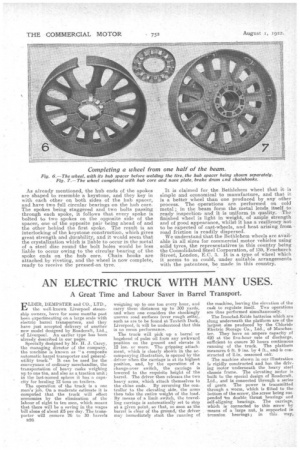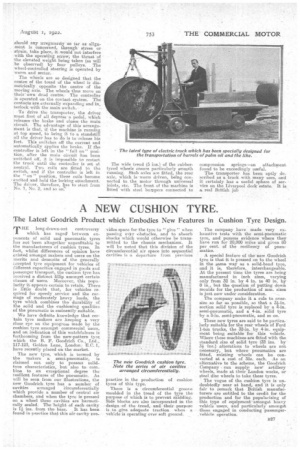AN ELECTRIC TRUCK WITH MANY USES.
Page 10

Page 11

If you've noticed an error in this article please click here to report it so we can fix it.
A Great Time and Labour Saver in Barrel Transport.
ELDER, DEM.PSTER and CO., LTD., the well-known Liverpool steamship owners, have for some months past been experimenting on a large scale with electric barrel transporters, and they have just accepted delivery of another new model designed by Roadcraft, Ltd.,_ of Liverpool. An earlier type has been already described in our pages.
Specially designed by Mr. H. J. Carey, the managing director of the company, the machine is known as "a composite automatic barrel transporter and generalutility truck." It can he used for the conveyance of ordinary merchandise the transportation of heavy casks weighing up to one ten, and also as a traction unit ; in the last-named sphere it has a capacity for hauling 12 tons on trailers.
The operation of the truck is a one man's job. On a moderate estimate it is computed that the truck will effect economies by the elimination of the labour of eight to ten men, which means that there will be a saving in the wages bill alone of about .£5 per day. The transporter will remove 26 to 30 barrels
B26
weighing up to one ton every hour, and carry them distances up to 300 yards, and when one considers the shockingly uneven road surfaces (over rough setts), such as are to be found at Toxteth Dock; Liverpool, it. will he understood that this is no mean performance.
The truck will pick up a barrel or hogshead of palm oil from any awkward position on the ground and elevate it 12 ins. or more. The gripping attachment, which is clearly shown in the accompanying illustration, is opened by the driver when the carriage is at its highest position, and, by the operation of a change-over switch, the carriage is lowered to the requisite height of the barrel. The driver then releases the two heavy arms, which attach themselves to the chine ends. By reversing the controller to the elevating side, the arms then take the entire weight of the load. By means of a limit .switch, the travelling carriage is automatically set to stop at a given point, so that, so soon as the barrel is clear of the ground; the driver may immediately start the running of
the machine, leaving the elevation of the cask to regulate itself. Two operations are thus performed simultaneously. '
The Ironclad-EY:We batteries which are slung underneath the platform are of the largest size produced by the Chloride Electric Storage Cu., Ltd., oP Manchester. They have an ampere capacity of 420 at the five-hour rate of discharge, sufficient to ensure 10 hours continuous running of the truck. The platform measures 6 ft. 9 ins. by 4 ft., and is constructed of -2-in, seasoned oak.
The machine shown in our illustration
rigidly constructed and has the driving motor underneath the heavy steel chassis frame. The elevating motor is built to the special design of''Roadcraft, Ltd., and in connected through a series of gears. The power is transmitted through a worm, which is fitted to the bottom of the screw' the screw being sus. pended Ian double thrust bearings and self-aligning bearings. The carriage, which is connected to this screw by means of a 'large nut, is supported in trunnion bearings; in this way,
should any irregmarity 'so tar as alignment is concerned, through stress or . strain, take place, it would not interfere with the operating screw; the thrust of the elevated weight being taken (as will be observed) by low pulleys. The wheel-controlled steering is operated by worm and sector. •
The wheels are so designed that the centre of the tread of the wheel is diametrically opposite • the centre of the movingaxis. The wheels thus move on theirs-own dead centre, • The controller is operated on the contact system. The contacts are, externally expanding and in_
terlock with the main switch. . •
To drive the transporter, the driver .must first of all depress a pedal, which releases. the brake and closes the Main circuit. The advantage of this arrangemeat is that, if the machine is running at top speed, to bring it to a standstill all the driver has to do is to.release his feet. This switches off the current and automatically applies the brake. If the controller is left in the 'full on" position, after the main circuit has been switched off, it is impossible to restart the truck until the controller is set at neutral. Two coils are fitted to the switch, and if the controller is left in the "on " position, these coils become
• excited and hold the locking attachment. The driver, therefore, as to start from No. 1, No. 2, and so on. The wide tread (5 ins.) of the rubbertyred wheels ensure particularly smooth running. Stub axles are fitted, the rear axle, which is worm driven, being connected to, the motor through universal joints, etc. The front of the machine is fitted with steel busspers connected to compression springs--an attachment found to be exceedingly useful.
The transporter has been aptly described as a truck with many uses, and it certainly has a useful sphere of service on the Liverpool dock estate. It is a real British job






























